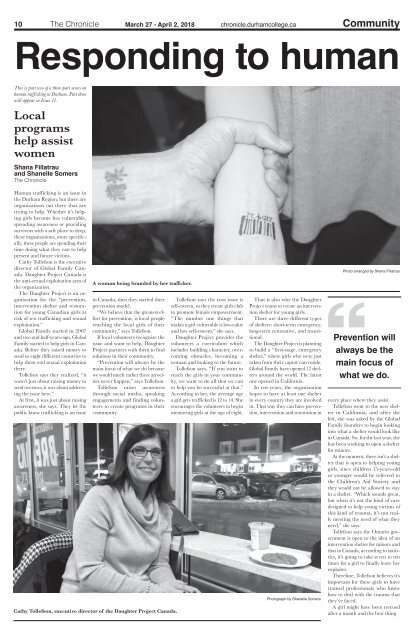You also want an ePaper? Increase the reach of your titles
YUMPU automatically turns print PDFs into web optimized ePapers that Google loves.
<strong>10</strong> The <strong>Chronicle</strong> March 27 - April 2, 20<strong>18</strong> chronicle.durhamcollege.ca Community<br />
Responding to human<br />
This is part two of a three-part series on<br />
human trafficking in Durham. Part three<br />
will appear in <strong>Issue</strong> 11.<br />
Local<br />
programs<br />
help assist<br />
women<br />
Shana Fillatrau<br />
and Shanelle Somers<br />
The <strong>Chronicle</strong><br />
Human trafficking is an issue in<br />
the Durham Region, but there are<br />
organizations out there that are<br />
trying to help. Whether it’s helping<br />
girls become less vulnerable,<br />
spreading awareness or providing<br />
survivors with a safe place to sleep,<br />
these organizations, more specifically,<br />
these people are spending their<br />
time doing what they can to help<br />
present and future victims.<br />
Cathy Tollefson is the executive<br />
director of Global Family Canada.<br />
Daughter Project Canada is<br />
the anti-sexual exploitation arm of<br />
the organization.<br />
The Daughter Project is an organization<br />
for the “prevention,<br />
intervention shelter and restoration<br />
for young Canadian girls at<br />
risk of sex trafficking and sexual<br />
exploitation.”<br />
Global Family started in 2007<br />
and two and half-years-ago, Global<br />
Family started to help girls in Canada.<br />
Before they raised money to<br />
send to eight different countries to<br />
help them end sexual exploitation<br />
there.<br />
Tollefson says they realized, “it<br />
wasn’t just about raising money to<br />
send overseas, it was about addressing<br />
the issue here.”<br />
At first, it was just about raising<br />
awareness, she says. They let the<br />
public know trafficking is an issue<br />
A woman being branded by her trafficker.<br />
in Canada, then they started their<br />
prevention model.<br />
“We believe that the greatest effort<br />
for prevention, is local people<br />
reaching the local girls of their<br />
community,” says Tollefson.<br />
If local volunteers recognize the<br />
issue and want to help, Daughter<br />
Project partners with them to find<br />
solutions in their community.<br />
“Prevention will always be the<br />
main focus of what we do because<br />
we would much rather these atrocities<br />
never happen,” says Tollefson.<br />
Tollefson raises awareness<br />
through social media, speaking<br />
engagements and finding volunteers<br />
to create programs in their<br />
community.<br />
Cathy Tollefson, executive director of the Daughter Project Canada.<br />
Tollefson says the root issue is<br />
self-esteem, so they create girls club<br />
to promote female empowerment.<br />
“The number one things that<br />
makes a girl vulnerable is low-value<br />
and low self-esteem,” she says.<br />
Daughter Project provides the<br />
volunteers a curriculum which<br />
includes building character, overcoming<br />
obstacles, becoming a<br />
woman and looking to the future.<br />
Tollefson says, “If you want to<br />
reach the girls in your community,<br />
we want to do all that we can<br />
to help you be successful at that.”<br />
According to her, the average age<br />
a girl gets trafficked is 12 to 14. She<br />
encourages the volunteers to begin<br />
mentoring girls at the age of eight.<br />
That is also why the Daughter<br />
Project wants to create an intervention<br />
shelter for young girls.<br />
There are three different types<br />
of shelters: short-term emergency,<br />
long-term restorative, and transitional.<br />
The Daughter Project is planning<br />
to build a “first-stage, emergency<br />
shelter,” where girls who were just<br />
taken from their captor can reside.<br />
Global Family have opened 12 shelters<br />
around the world. The latest<br />
one opened in California.<br />
In ten years, the organization<br />
hopes to have at least one shelter<br />
in every country they are involved<br />
in. That way they can have prevention,<br />
intervention and restoration in<br />
Photograph by Shanelle Somers<br />
Photo arranged by Shana Fillatrau<br />
Prevention will<br />
always be the<br />
main focus of<br />
what we do.<br />
every place where they assist.<br />
Tollefson went to the new shelter<br />
in California, and after she<br />
left, she was asked by the Global<br />
Family founders to begin looking<br />
into what a shelter would look like<br />
in Canada. So, for the last year, she<br />
has been working to open a shelter<br />
for minors.<br />
At the moment, there isn’t a shelter<br />
that is open to helping young<br />
girls, since children 15-years-old<br />
or younger would be referred to<br />
the Children’s Aid Society and<br />
they would not be allowed to stay<br />
in a shelter. “Which sounds great,<br />
but when it’s not the kind of care<br />
designed to help young victims of<br />
this kind of trauma, it’s not really<br />
meeting the need of what they<br />
need,” she says.<br />
Tollefson says the Ontario government<br />
is open to the idea of an<br />
intervention shelter for minors and<br />
that in Canada, according to statistics,<br />
it’s going to take seven to ten<br />
times for a girl to finally leave her<br />
exploiter.<br />
Therefore, Tollefson believes it’s<br />
important for these girls to have<br />
trained professionals who know<br />
how to deal with the trauma that<br />
they’ve faced.<br />
A girl might have been rescued<br />
after a month and the best thing


















